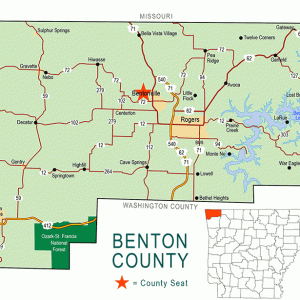calsfoundation@cals.org
Pine Log (Benton County)
The Pine Log community lies deep in the hills of the Lost Bridge area of Benton County. Union veteran Nathaniel Mattox Doke came to the area in about 1872. Families settled there at a time when northwestern Arkansas growth was starting to include post offices, churches, schools, and businesses. Railroad construction was moving westward, and farming was the livelihood for most people in the area.
Nathaniel M. “Preacher” Doke owned 200 acres in Pine Log, and the White River ran through some of his acreage. (If it flooded, his crops were ruined.) He grew corn and developed orchards of peaches and apples, and had cows, hogs, and cashmere goats. Doke was a Civil War veteran, preacher, carpenter, blacksmith, and fiddler. Recognizing the lack of education in the area, he hewed logs and built a one-room schoolhouse in Pine Log. He made seats for the students and bought basic books, slates, and necessary writing material, and proceeded to teach school. In later years, he and his family moved to Garfield Mountain. After losing his hearing, he was struck by a train and died. Doke was the father of twenty-three children.
Bill Maloney was the son of Lafe and Elizabeth Maloney and grew up in Pine Log with six brothers and four sisters. He relayed stories of much hard work farming and a “Maloney still on a stream over the ridge. It tested 125 proof….they took the mash to feed the hogs who got real fat on it.”
Pine Log School had many different teachers. One teacher drove a buggy on Monday morning from Pea Ridge (Benton County), about fourteen miles, to teach and then boarded with some of the parents until Friday. The school was in operation from 1889 until 1944, when it was consolidated with Garfield (Benton County). The log schoolhouse no longer stands.
Rural areas were usually slow to receive services, but in the late 1920s, the county planned a bridge across the White River for easier transportation between Rogers (Benton County), Bentonville (Benton County), and Eureka Springs (Carroll County). The bridge was completed in 1929, but it could not be used because it was unfinished on the Eureka Springs (eastern) side, with a thirty-foot drop. The county ran out of money, and locals had to use a ladder to access the eastern side. A Rogers newspaper editor said, “Well this is really a lost cause, lost cause bridge,” and the name stuck as the Lost Bridge. It was inaccessible for about five years and then completed when money was allotted. The Lost Bridge was destroyed when the White River flooded in 1943, and a low-water bridge replaced it. The bridge remained passable only when the White River was low. After the dam was built to create Beaver Lake, it disappeared under hundreds of feet of water.
One local character who lived in the Pine Log area was Ernest Shilling, who became known as By Golly. He came to the United States from Switzerland and traveled until he reached Eureka Springs. After a few years, he bought a farm near the White River in Benton County. He kept burros, goats, dogs, and chickens. He painted signs for businesses and churches and was well known. He got his nickname from using the phrase in all his sentences, as in “by golly this” and “by golly that.” If he got a check, he would say, “Oh, just write it to By Golly. The bank cashes them.”
The White River basin became part of Beaver Lake with the five multi-purpose projects in the Flood Control Act of 1954. Construction began in 1960 and was completed in 1966 to generate hydroelectric power, provide a water supply, and create opportunities for recreation. Properties were sold and buildings razed. As the lake rose, better roads were developed for another crop of homeowners. No businesses or churches exist in Pine Log in the twenty-first century, and brush marks the spot of the old Pine Log schoolhouse.
For additional information:
Benton County Heritage Committee. History of Benton County, Arkansas. Rogers: Benton County Heritage Committee, 1991.
Jines, Billie. Benton County Schools That Were. Vol. 1 Ozark, MO: Dogwood Publishing, 1989.
Mahurin, Wanda. The History of Garfield, Arkansas, 1874–1996. Ozark, MO: Dogwood Printing, 1996.
Ross, Dorothy, Alice Carter, Amelia Osborn, Elaine Osborn, Bob Ross, and Cathy Ross, eds. Garfield and Her Ten Schools and Some Adjoining Schools. N.p.: 2000.
Patricia Lucille Heck
Glade Community Historical Society
 Benton County Map
Benton County Map 




Comments
No comments on this entry yet.